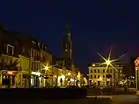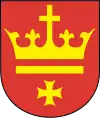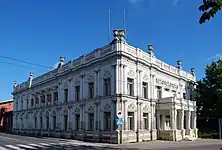Starogard Gdański
Starogard Gdański (Polish pronunciation: [staˈrɔɡard ˈɡdaj̃skʲi]; until 1950 Starogard, meaning approximately "the old stronghold"; Pomeranian/Kashubian: Starogarda; German: Preußisch Stargard) is a town in Pomeranian Voivodeship in northern Poland with 48,328 inhabitants (2004).
Starogard Gdański | |
|---|---|
    
| |
 Flag  Coat of arms | |
 Starogard Gdański  Starogard Gdański | |
| Coordinates: 53°58′N 18°32′E | |
| Country | |
| Voivodeship | |
| County | Starogard |
| Gmina | Starogard Gdański (urban gmina) |
| Established | 1198 |
| Town rights | 1348 |
| Government | |
| • Mayor | Janusz Stankowiak |
| Area | |
| • Total | 25.27 km2 (9.76 sq mi) |
| Population (2006) | |
| • Total | 48,136 |
| • Density | 1,900/km2 (4,900/sq mi) |
| Time zone | UTC+1 (CET) |
| • Summer (DST) | UTC+2 (CEST) |
| Postal code | 83-200 |
| Area code(s) | +48 58 |
| Car plates | GST |
| Website | http://www.starogard.pl |
Starogard is the capital of Starogard County. It is also the second biggest town (after Tczew) of the ethnocultural region Kociewie and is populated by Kocievians.
Geographical location
Starogard Gdański is located in Pomerania on the small river Wierzyca, about 21 kilometres (13 miles) south-west of Tczew, 40 km (25 mi) south of Gdańsk and 67 km (42 mi) north-east of Chojnice. It is 50 km (31 mi) from the Tricity (Polish: Trójmiasto) agglomeration on the coast of Gdańsk Bay.
Etymology
The name Starogard means "old city" in the Pomeranian language. Gdański is appended in the 20th century to the name to differentiate it from other places named Starogard. The German name Preußisch Stargard (Prussian Stargard) is similarly used to disambiguate from other places named Stargard. (See Stargard (disambiguation)).
History

Archeological evidence indicates remnants of a neolithic settlement from four to five thousand years ago.
The area became part of the emerging Polish state under its first ruler Mieszko I of Poland in the 10th century, and during the fragmentation period in Poland it was part of a Pomeranian duchy, which separated from Poland in 1227. Starogrod (as Starigrod) was first mentioned in 1198 when Duke Grzymisław II of Pomerania granted the settlement to the Knights Hospitaller. The Slavic name Stargarde was mentioned in 1269. In 1282, Mestwin II and Polish Duke Przemysł II signed the Treaty of Kępno, which transferred the suzerainty over Gdańsk Pomerania including Starogard to Przemysł II and reunited the region with Poland. Together with the rest of Gdańsk Pomerania it came under the rule of the Teutonic Knights during the 1308 Teutonic takeover of Danzig (Gdańsk). In 1348 the town received city rights under Kulm Law by Grandmaster Heinrich Dusemer.
Since 31 March 1440 Starogard was a member of the Prussian Confederation.[1] It took an active part in the 1454 uprising against the Teutonic Order that led to the Thirteen Years' War (1454–66). In 1454, Polish King Casimir IV Jagiellon re-incorporated the region to the Kingdom of Poland upon the request of the Confederation, and the city recognized the King as the rightful ruler. In 1461 the Teutonic Knights took over Starogard, which was then eventually recaptured by Poland in July 1466. In the peace treaty signed in Toruń a few months later in 1466, the Teutonic Knights renounced any claims to the city, and recognized it as part of Poland.[2] It became part of the Pomeranian Voivodeship in the province of Royal Prussia in the larger Greater Poland Province of the Polish Crown. It remained under Polish rule until the First Partition of Poland in 1772, when it became part of the Kingdom of Prussia.
In 1871, a large vodka distillery was built on the western end of town, which survived both world wars and today produces Sobieski and Krupnik. It is one of Europe's oldest continuously-run vodka distilleries, and one of only a very small handful of vodka distilleries predating 1945.[3]
Until 1920 Stargard belonged to the administrative district of Regierungsbezirk Danzig in the Province of West Prussia. After World War I Stargard was reincorporated to Poland, which just regained independence as the Second Polish Republic. In the interbellum it was a county seat administratively located in the Pomeranian Voivodeship of Poland.
World War II

During the joint German-Soviet invasion of Poland, which started World War II in September 1939, the town was invaded by Nazi Germany, and then the German Einsatzkommando 16 and SS Wachsturmbann "Eimann" entered the town to commit various crimes against Poles.[4][5] Under German occupation, the town was annexed into the newly formed Regierungsbezirk Danzig in the new province of Reichsgau Danzig-West Prussia. The Polish population was subjected to mass arrests, imprisonment, tortures, massacres, expulsions, deportations to Nazi concentration camps and to forced labour.
The Germans immediately carried out mass arrests of Polish teachers, priests and local activists in the town and county as part of the Intelligenzaktion.[6] Arrested Poles were then held both in the pre-war prison and the medieval Gdańsk Tower and often subjected to brutal beatings[7] and mistreatment, especially clergymen, some of whom had even swastikas cut into their foreheads.[8] Already in September 1939, the Germans murdered 150 Poles, including inhabitants of Starogard, Skórcz and Gdynia, in the town and its vicinity.[6]
Beginning in September 1939 in nearby Szpęgawski Forest (north-east of the town) Germans killed in mass executions about 7,000 Poles, among them 1,680 Kocborowo (district of Starogard) and Świecie psychiatric hospitals patients. About 500 handicapped children were killed in the hospital, in Action T4. 2,842 patients died between 1940-1944. Polish hospital staff was either murdered in the Szpęgawski Forest or deported to Nazi concentration camps or to forced labour to Germany.[9] A local parish priest was murdered in a massacre of around 230 Poles in Płutowo.[10] The Germans also established and operated a subcamp of the Stutthof concentration camp in the town.[11]
Despite such circumstances, Poles still organized an underground resistance movement, including the Home Army and Jaszczurka organizations.[12]

In 1945 the German occupation ended and the town was restored to Poland, however with a Soviet-installed communist regime, which remained in power until the Fall of Communism in the 1980s.
Contemporary history
The Jord-Just youth anti-communist resistance organization was established in Starogard in 1951 by 16-year old girl Teresa Block.[13] The organization was eventually crushed by the communists, who sentenced 17 teenage members to 1.5 to 9 years in prison.[13]
Number of inhabitants by year
| Year | Number |
|---|---|
| 1772 | 1,103 |
| 1782 | 1,410 |
| 1831 | 3,145 |
| 1875 | 6,022 |
| 1880 | 6,253 |
| 1890 | 7,080 |
| 1905 | 10,485 |
| 1921 | 13,360 |
| 1943 | 17,895 |
| 1960 | 25,800 |
| 1970 | 33,700 |
| 1980 | 44,200 |
| 1990 | 49,500 |
| 2001 | 49,884 |
| 2012 | 49,072 |
Note that the above table is based on primary, possibly biased, sources.[14][15][16][17]
Major corporations

- Polpharma SA
- Destylarnia Sobieski SA
Education
- Pomorska Szkoła Wyższa w Starogardzie Gdańskim
Sports

The town's most notable sports club is basketball team SKS Starogard Gdański, which plays in the Polish Basketball League (Poland's top division), Polish Cup winners in 2011, and runners-up in 2006. The local football club is KP Starogard Gdański, and it competes in the III liga (Polish fourth tier). The team plays in green and white at the Stadion Miejski.
The town was home to the Polish World Cup football player and Olympic Gold Medal winner Kazimierz Deyna. Deyna grew up in Starogard Gdański, and the local Stadion Miejski im. Kazimierza Deyny is named after him. There is also a statue to him in the seating area of the ground, and a heritage trail through the town which takes in his birthplace, family home and murals to the sportsman. Starogard Gdański also boasted Olympic bronze medal winner Oktawia Nowacka.
Famous residents

- Adolf Lesser (1851–1926) a German physician who specialized in forensic medicine
- Michael F. Blenski (1862–1932), Wisconsin politician
- Adolf Wallenberg (1862–1949) a German internist and neurologist
- John S. Flizikowski, (1868–1934) a Chicago architect
- Ferdinand Noeldechen (1895–1951), general
- Theo Mackeben (1897–1953) a German pianist, conductor and composer, particularly of film music
- Kazimierz Kropidłowski (1931–1998) a Polish long jumper, competed at the 1956 Summer Olympics
- Henryk Jankowski (1936-2010) a Polish Roman Catholic priest and Member of Solidarity movement
- Kazimierz Deyna (1947–1989), soccer player, over 600 pro games and 97 for Poland
- Władysław Wojtakajtis (1949–2016) a Polish swimmer, competed at the 1968 and 1972 Summer Olympics
- Andrzej Grubba (1958–2005) a Polish table tennis player
- Maria Kamrowska (born 1966) a retired Polish heptathlete.
- Paweł Papke (born 1977) a former Polish volleyball player
- Piotr Wiśniewski (born 1982) a Polish footballer, who played 230 games for Lechia Gdańsk
- Oktawia Nowacka (born 1991) a Polish modern pentathlete and bronze medalist in the 2016 Summer Olympics
Partnership towns
|
|
|
| Wikimedia Commons has media related to Starogard Gdański. |
References
- Paweł Czaplewski Senatorowie świeccy, podskarbiowie i starostowie Prus Królewskich, 1454-1772, Tomy 26-28 z Roczniki Towarzystwa Naukowego w Toruniu, 1921, p. 178 Google Books
- Górski, Karol (1949). Związek Pruski i poddanie się Prus Polsce: zbiór tekstów źródłowych (in Polish). Poznań: Instytut Zachodni. pp. 89, 207.
- "Destylarnia Sobieski S.A. w Starogardzie Gdańskim". www.wodki.gda.pl (in Polish). Retrieved 19 April 2018.
- Wardzyńska, Maria (2009). Był rok 1939. Operacja niemieckiej policji bezpieczeństwa w Polsce. Intelligenzaktion (in Polish). Warszawa: IPN. p. 106.
- The Pomeranian Crime 1939. Warsaw: IPN. 2018. p. 9.
- Wardzyńska (2009), p. 108
- Wardzyńska (2009), p. 108, 120
- The Pomeranian Crime 1939, p. 13
- Wardzyńska (2009), p. 151-152
- Wardzyńska (2009), p. 166
- "Preußisch-Stargard (Starogard)" (in German). Retrieved 2 January 2021.
- Małgorzata Rogala. "Upamiętnili Jaszczurkowców". Starogard.pl (in Polish). Retrieved 2 January 2021.
- "Uroczyste odsłonięcie tablicy upamiętniającej członków Młodzieżowej Antykomunistycznej Organizacji Jord-Just – Starogard Gdański, 1 marca 2019". IPN (in Polish). Retrieved 2 January 2021.
- Johann Friedrich Goldbeck: Volständige Topographie des Königreichs Preußen. Part II: Topographie von West-Preussen, Marienwerder 1789, pp. 62–63.
- Meyers Großes Konversations-Lexikon, 6th edition, Vol. 18, Leipzig and Vienna 1909, p. 857.
- Michael Rademacher: Deutsche Verwaltungsgeschichte Westpreußen, Kreis Preußisch Stargard (2006).
- August Eduard Preuß: Preußische Landes- und Volkskunde. Königsberg 1835, S. 388–389, Nr. 21.





